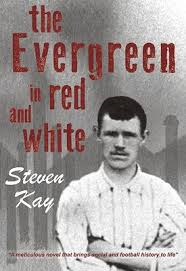Book Review: The Evergreen in red and white: a novel by Steven Kay
 I’ll be totally honest and say that I knew nothing of Rabbi ‘Rab’ Howell before reading this book. If you search on the internet, Wikipedia details that he, “…was a nineteenth-century professional footballer who played for Sheffield United and Liverpool primarily as a defender. Born in Wincobank in Sheffield he was of Romani descent and was the first Romani to play for England, winning two caps…” His two caps came against Ireland in 1895, in which he scored in a 9-0 win and Scotland in 1899. His Wikipedia entry also states that, “…serious allegations were to be levelled at him…as in his final season at the club he was believed to have attempted to throw a game against rivals for the Championship Sunderland, scoring two blatant own goals. No charges were ever brought but Howell only played one more game for United before being quietly sold to Liverpool…”
I’ll be totally honest and say that I knew nothing of Rabbi ‘Rab’ Howell before reading this book. If you search on the internet, Wikipedia details that he, “…was a nineteenth-century professional footballer who played for Sheffield United and Liverpool primarily as a defender. Born in Wincobank in Sheffield he was of Romani descent and was the first Romani to play for England, winning two caps…” His two caps came against Ireland in 1895, in which he scored in a 9-0 win and Scotland in 1899. His Wikipedia entry also states that, “…serious allegations were to be levelled at him…as in his final season at the club he was believed to have attempted to throw a game against rivals for the Championship Sunderland, scoring two blatant own goals. No charges were ever brought but Howell only played one more game for United before being quietly sold to Liverpool…”
In The Evergreen (a reference to Howell’s nickname, who in the modern game would be seen as a player with a ‘big-engine’), author Steven Kay offers a different perspective on the players move from Sheffield United to Liverpool. Kay hints that Howell was transferred as the United board discovered that the player was having an affair and to distance themselves from any scandal, Howell was quickly sold to Liverpool.
Although this book is written as a novel, Kay believes that his research has created a version of events that is, “…as close to the truth as possible…”, whilst being, “…a fictional account based on what facts that can be gleaned…”
The book begins in April 1897 and follows a year in Rab’s life ‘on and off the pitch’, including the 1897/98 First Division season. Part of the backdrop to the story is the visit of Queen Victoria to Sheffield as she toured the country during her Diamond Jubilee celebrations. In this respect Kay offers the reader a book which works on the levels of football and social history.
The author has to be congratulated for the research that informs the book, not only into the Victorian world of football, but for the portrayal of Victorian life in Sheffield. As somebody who has spent some time in the Steel City, this book has had me searching for images of Victorian Sheffield. Indeed, if Thomas Hardy and or Charles Dickens did football, then this book would be the result.
Footballers accused of match-fixing and involved in affairs of the heart? Whether it’s the Nineteenth, Twentieth or Twenty First Century – some things will never change.
Pingback: Top Ten Football Books: Steven Kay – football book reviews